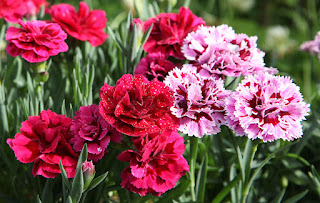
The carnation is a flowering plant that belongs to the Caryophyllaceae family. There are more than 300 types of carnations that can be found around the world. These plants come from Europe and Asia. Carnations have been grown for at least 2000 years for their beautiful flowers and intense scent. Carnations require well-drained soil, adequate moisture, and direct sunlight for successful growth. According to legend, the first carnation was made from tears of the Virgin Mary when Christ was crucified. In most countries these flowers are a symbol of the labor movement and mother’s love. Carnations symbolize bad luck in France, where they are mainly used to make funeral bouquets.
Ohio is the only American state that has chosen a carnation — the scarlet carnation — as its state flower.
Carnation is herbaceous plant that can reach 31 inches in height.
The French use the oil from carnations to treat hair loss, relax muscles, and help clean and protect people’s skin as an ingredient in skin cream.
Carnation has 6 inches long slender leaves. They are usually grayish or bluish green in color and covered with waxy substance.
Carnations are often worn on special occasions, especially Mother’s Day and weddings.
Carnations produce either one or couple of flowers (up to 5) that are grouped in inflorescence. Flower contains both male (stamens) and female (pistil) reproductive organs.
In Korea, carnations express admiration, love and gratitude.
Natural (original) color of the flower is purple-pink. Carnations in various shades of white, yellow, orange, red and green were created by humans. Most varieties of carnations were produced via selective breeding. Blue-mauve type of carnation was produced via genetic engineering.
Red carnations are worn on May Day as a symbol of socialism and the labour movement in some countries, such as Austria, Italy, and successor countries of the former Yugoslavia.
White carnation will change its color after adding food coloring to the water. Flower will change its color after 24 hours.
The red carnation is also the symbol of the Portuguese Carnation Revolution.
Each color of carnation has specific meaning. White symbolizes purity, yellow – disappointment, pink – mother’s love, red – true love while purple symbolizes capriciousness.
Green carnations are for St. Patrick’s Day and were famously worn by the Irish writer Oscar Wilde.
Latin word for carnation is “Dianthus” which means “flower of the gods”.
At the University of Oxford, carnations are traditionally worn to all examinations; white for the first exam, pink for exams in between, and red for the last exam.
Carnations were cultivated as garden flowers in the ancient Rome and Greece.
Colombia is the largest carnation producer in the world.
White carnations are inevitable part of wedding bouquets and bouquets prepared for the first wedding anniversary. Carnations are birth flowers for all people that are born in January. These flowers are often used as decoration for tuxedoes. Bouquets made of pink carnations are traditionally prepared for the Mother’s day.
The largest flower awareness ribbon (which was created to raise awareness for breast cancer research) was made out of105,000 pink carnations, according to Guinness World Records.
Besides in bouquets, flowers of carnations can be used as food. They can be consumed in the form of salads or they can be used as decoration for cakes and other desserts.
Although dangerous for pets, carnations are edible for humans and can be used for decorating cakes or for eating.
Carnations are used as flavoring agents in the manufacture of beer, wine and other alcoholic beverages.
Colombia is the greatest producer of carnations in the world.
Carnation petals are also used to make Chartreuse, a French liqueur.
Carnations are national flowers of countries such as Monaco, Spain, Slovenia and Ohio. They are also used as a symbol of different fraternities and sororities.
Carnations can propagate via seeds and plant cuttings.
Carnations are perennial plants, which mean that they can live more than 2 years. Carnations also have long lifespan in the vase – they can remain fresh up to 14 days after removal from the ground.
Carnation flowers also have a ton of symbolism and meanings. In Christian lore, it was said that carnations sprouted from the ground where the Virgin Mary’s tears landed as she watched Jesus carry the cross, forever associating the flower with motherly love.
Carnation FAQs:
Here are some of the most common questions people search about carnations, answered in detail:
1. What is a carnation?
Carnations are beautiful, frilly flowers native to Eurasia, particularly Asia and Europe. They have been cultivated for over 2,000 years and come in a wide variety of colors, though naturally they were originally pinkish-purple. Carnations are known for their long vase life and are popular choices in bouquets and floral arrangements.
2. What do carnations symbolize?
The meaning of a carnation can vary depending on the color. Generally, carnations symbolize love, admiration, and devotion. Here’s a breakdown of some popular carnation colors and their meanings:
- Red: Deep love and admiration
- Pink: Lighthearted love, gratitude, and affection
- White: Innocence, purity, and sympathy
- Yellow: Cheer, joy, and friendship
3. How do I care for carnations?
Carnations are known for being easy to care for. Here are some tips to extend the life of your carnations:
- Cut the stems diagonally: This helps them absorb water more efficiently.
- Remove foliage below the waterline: This prevents bacteria growth in the vase.
- Use fresh, lukewarm water: Add flower food if available.
- Place them in a cool, well-lit location: Avoid direct sunlight.
- Change the water every 2-3 days: Recut the stems each time.
4. Are carnations edible?
Yes, carnation petals are edible and can be used in salads, teas, or even as a garnish. The petals have a slightly spicy or peppery flavor. However, only consume carnations grown organically and free of pesticides.
5. What are some interesting facts about carnations?
- Carnations are the birth flower for January.
- They are also the official flower for 1st wedding anniversaries.
- The name “carnation” likely comes from the Greek word “coronation” as they were used in Greek ceremonial crowns.
- Carnations were once believed to have medicinal properties.
- In some cultures, carnations are used in funeral arrangements.
- They are the national flower of three countries: Colombia, Spain, and Slovenia.
6. What are some different types of carnations?
There are many varieties of carnations, but some of the most common include:
- Standard carnations: These are the classic large-flowered carnations with full blooms.
- Spray carnations: These have smaller blooms on branching stems, ideal for arrangements.
- Miniature carnations: Also called “baby” carnations, these have small, delicate blooms.
- Dianthus carnations: These are a special type of carnation with fringed petals.
I hope this comprehensive FAQ answers all your questions about carnations! Feel free to ask if you have anything else you’d like to know.









